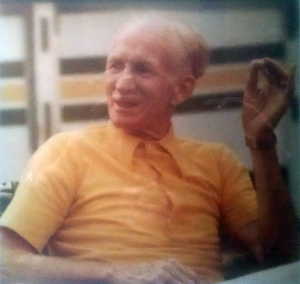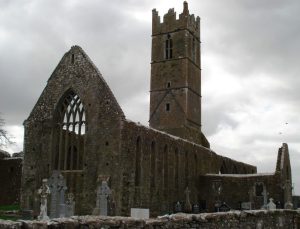 James Michael Flaherty was born on Kent St. in Albany in 1952, neighbor to a cluster of Irish families such as the Regans, the Doyles, and the Leonards. His parish was St. Patrick’s, the pastor was Monsignor Delaney, the nuns had brogues, and other Irish names like O’Neill, Tracey, and Killalea appeared on the class roster. His father, James Joseph “Red” Flaherty was born on a farm in Claregalway, Co. Galway in 1906, the third child of eight children. Red was ten in 1916, but he remembered an ambush the men in his town organized at nearby Carnmore Cross when the British run Royal Irish Constabulary were being called from the west into Dublin after the GPO was taken on April 24, 1916.
James Michael Flaherty was born on Kent St. in Albany in 1952, neighbor to a cluster of Irish families such as the Regans, the Doyles, and the Leonards. His parish was St. Patrick’s, the pastor was Monsignor Delaney, the nuns had brogues, and other Irish names like O’Neill, Tracey, and Killalea appeared on the class roster. His father, James Joseph “Red” Flaherty was born on a farm in Claregalway, Co. Galway in 1906, the third child of eight children. Red was ten in 1916, but he remembered an ambush the men in his town organized at nearby Carnmore Cross when the British run Royal Irish Constabulary were being called from the west into Dublin after the GPO was taken on April 24, 1916.
County Galway was one of the few places outside Dublin that took an active role in the Easter rising. There were several places in Ireland scheduled to revolt simultaneously on Easter Sunday 1916, but after Roger Casement was arrested on the Kerry shore with a cashe of German guns on April 21, 1916, Eoin McNeill countermanded the Easter Sunday plan with an ad in the Irish newspapers. The IRB’s inner circle countered the countermand and rescheduled the rising for Easter Monday, but the rest of the country was then confused as to what to do and thus did not launch revolts. When word of the Dublin rising reached Galway on Tuesday morning, volunteers from Claregalway and Castlegar mobilized. Over 30 men from Claregalway rendezvoused with men from Castlegar at Carnmore Cross, ten miles east of Galway City. The plan was to rest at Carnmore and travel together farther east to Moyode at day break, and await orders. Before sunrise, a group of RIC men approached Carnmore Cross and shots were fired. One RIC man was killed in the skirmish. Jim heard the story as a teenager in the Claregalway home his father grew up in around the fire with his aunts and uncles. They told Jim the news of the shooting permeated the farmlands, and the tragedy was that the RIC man was Irish, too.
Sadly, the Galway men never made it to Dublin; communication out of Dublin all but stopped by Wednesday and within a week, the rebels were defeated in Dublin. By May of 1916, 200 British police came into Galway to assist the local RIC. Irish homes were violently searched for weapons, and in one week 270 Galway men were arrested and sent to prison. By July 1917, most were released and came home, forming the true heart of the Galway IRA in the War of Independence. Red and his siblings remembered the Black and Tans. When the Flaherty’s and their neighbors heard the lorries rattling down the narrow road, everyone would get out of sight. The Tans would pick one home to ransack and then move on.
Red immigrated to the United States in 1927 after secondary school. As a third son, he figured there wouldn’t be much of the farm remaining for him, so he left for the adventure and went to relatives in Boston to join a Hurling team. He left Boston in 1930 and did various jobs across the country from Maine to Los Angeles. In 1937, he moved to Albany having heard a Gaelic football team was forming and stayed until he was drafted in the first American draft of 1940 before Pearl Harbor. Red took part in the D-day invasion, and he was in the Ardennes Forest and the Battle of the Bulge in December 1944 through January 1945. After the war, Red got off the train in Albany and walked to the Shamrock Bar on Central Ave. to shouts of “Red’s back,” and married Helen Curren in 1947. He rounded off his working life at Beverwick and Shaefer Breweries.
 Jim and his sisters, Eileen and Maureen grew up amid Irish brogues, Irish neighbors, and Irish stories in his west Albany Kent St. neighborhood. Claregalway is still populated with many Flaherty’s – most of Red’s siblings remained, and their children and grandchildren own the original farm and much of the surrounding farmlands. Jim has visited the family in Claregalway half a dozen times since 1967, but the first visit is perhaps the most memorable for he had a glimpse of the Ireland his father grew up in. He was with his father and spent two weeks working on the farm. He learned to repair the thatched roof of the farmhouse which did not yet have running water and heat; he cut, stacked, and tied the hay; and he plowed the land guiding a rake behind a horse. It was the ’67 visit that Jim sat around the open fire with his father, aunts, and uncles and heard the stories of the revolutionary years.
Jim and his sisters, Eileen and Maureen grew up amid Irish brogues, Irish neighbors, and Irish stories in his west Albany Kent St. neighborhood. Claregalway is still populated with many Flaherty’s – most of Red’s siblings remained, and their children and grandchildren own the original farm and much of the surrounding farmlands. Jim has visited the family in Claregalway half a dozen times since 1967, but the first visit is perhaps the most memorable for he had a glimpse of the Ireland his father grew up in. He was with his father and spent two weeks working on the farm. He learned to repair the thatched roof of the farmhouse which did not yet have running water and heat; he cut, stacked, and tied the hay; and he plowed the land guiding a rake behind a horse. It was the ’67 visit that Jim sat around the open fire with his father, aunts, and uncles and heard the stories of the revolutionary years.
Jim graduated from Cardinal McCloskey in 1970 and just retired from forty-five years at the Fort Orange Club where he was the club general manager for the past twenty-one years.
